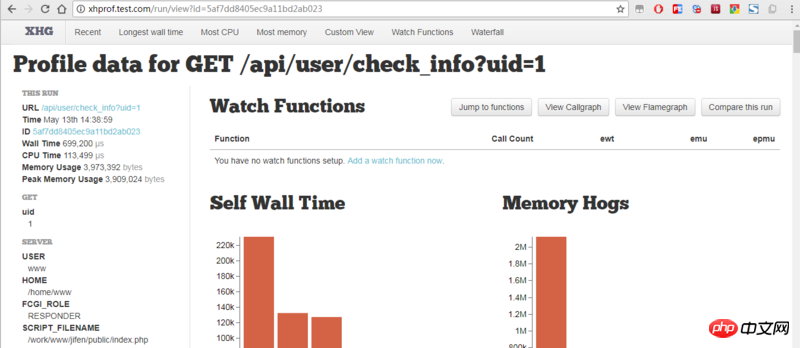使用XHProf分析PHP性能瓶頸的方法二
這篇文章主要介紹了關於使用XHProf分析PHP性能瓶頸的方法二,有著一定的參考價值,現在分享給大家,有需要的朋友可以參考一下
上一篇文章裡,我們介紹如何基於xhprof擴充功能來分析PHP效能,並記錄到日誌裡,最後使用xhprof擴充自帶的UI在web裡展示出來。本篇文章將講述2個知識點:
使用xhgui取代xhprof的預設UI介面,更便於分析
使用tideways擴充替換xhprof擴展
使用更漂亮的UI: xhgui
xhgui支援XHProf, Uprofiler或Tideways 擴展,也就是說,只要安裝了這幾種擴充中的一種即可。
本次測試中,實際使用了tideways擴充(切換為XHProf擴充後web裡看不到數據,原因未知。切換為Uprofiler也沒有數據。)。
xhprof雖然來自facebook但已經很久不更新,官方來源已經顯示This package is abandoned and no longer maintained(此包已廢棄,不再維護)。 tideways剛好相反,一直有商業公司在維護,並且積極的支持了PHP7。兩個擴充都是開源的,綜上所述我建議大家選擇tideways來分析程式碼。
安裝tideways擴充:
wget https://github.com/tideways/php-xhprof-extension/archive/v4.1.5.tar.gz -O php-xhprof-extension-4.1.5.tar.gz tar xzf /php-xhprof-extension-4.1.5.tar.gz cd php-xhprof-extension-4.1.5 phpize ./configure make && make install
安裝xhgui
cd /work/ git clone https://github.com/perftools/xhgui.git xhgui
如果需要安裝中文介面的,可以:
git clone https://github.com/laynefyc/xhgui-branch.git xhgui
然後安裝xhgui依賴:
cd xhgui php install.php
安裝需要等待幾分鐘,請耐心等待。
設定快取目錄的權限,允許nginx建立檔案:
chmod -R 777
xhgui已經把注入入口檔案都寫好了,位於external/header.php,無需我們手動去寫類似上一篇的xhprof.inc.php注入檔。
安裝MongoDB及客戶端
xhgui 把日誌寫到了MongoDB,所以使用xhgui需要安裝MongoDB服務端。此處省略安裝、啟動MongoDB服務端程序。
為提高MongoDB 的效能,你可以執行以下指令以新增索引:
$ /usr/local/mongodb/bin/mongo
> use xhprof
db.results.ensureIndex( { 'meta.SERVER.REQUEST_TIME' : -1 } )
db.results.ensureIndex( { 'profile.main().wt' : -1 } )
db.results.ensureIndex( { 'profile.main().mu' : -1 } )
db.results.ensureIndex( { 'profile.main().cpu' : -1 } )
db.results.ensureIndex( { 'meta.url' : 1 } )同理,由於xhgui是PHP寫的,還需要讀取MongoDB裡的數據,需要安裝MongoDB php 用戶端:
pecl install mongodb
然後在php.ini檔案中新增設定:
[mongo] extension=mongo.so
查看擴充功能是否已安裝成功:
php -m | grep mongo
然後重新啟動php-fpm服務。
配置xhgui
xhgui的config目錄有一個config.default.php,複製為config.php,如果mongodb位址不是預設的,修改:
'db.host' => 'mongodb://127.0.0.1:27017',
還有修改取樣頻率,預設是1/100,測試的話改為true:
'profiler.enable' => function() {
//return rand(1, 100) === 42;
return true;
},配置項目注入
上一篇文章中,我們介紹到,注入的入口檔案可以寫入php.ini或nginx,我建議寫在nginx配置,這樣只會影響該nginx對應的項目,而不是所有使用該php環境的項目。入口檔案使用xhgui自帶的注入檔:
jifen.cc.conf
location ~ \.php$ {
fastcgi_pass 127.0.0.1:9000;
fastcgi_index index.php;
fastcgi_param SCRIPT_FILENAME $document_root$fastcgi_script_name;
fastcgi_param PHP_VALUE "auto_prepend_file=/work/xhgui/external/header.php";
include fastcgi_params;
}設定xhgui web
我們修改xhprof.test.com.conf為:
server {
listen 80;
server_name xhprof.test.com;
#root /work/xhprof/xhprof_html;
root /work/xhgui/webroot/;
index index.php index.html;
location / {
if (!-e $request_filename) {
rewrite . /index.php last;
}
}
location ~ \.php$ {
fastcgi_pass 127.0.0.1:9000;
fastcgi_index index.php;
fastcgi_param SCRIPT_FILENAME $document_root$fastcgi_script_name;
include fastcgi_params;
}
}重啟nginx服務。
我們請求幾次應用的接口,打開瀏覽器輸入http://xhprof.test.com/,可以看到:
 點擊某次請求進去看詳情:
點擊某次請求進去看詳情: 
以上就是本文的全部內容,希望對大家的學習有所幫助,更多相關內容請關注PHP中文網!
相關推薦:
以上是使用XHProf分析PHP性能瓶頸的方法二的詳細內容。更多資訊請關注PHP中文網其他相關文章!

熱AI工具

Undresser.AI Undress
人工智慧驅動的應用程序,用於創建逼真的裸體照片

AI Clothes Remover
用於從照片中去除衣服的線上人工智慧工具。

Undress AI Tool
免費脫衣圖片

Clothoff.io
AI脫衣器

Video Face Swap
使用我們完全免費的人工智慧換臉工具,輕鬆在任何影片中換臉!

熱門文章

熱工具

記事本++7.3.1
好用且免費的程式碼編輯器

SublimeText3漢化版
中文版,非常好用

禪工作室 13.0.1
強大的PHP整合開發環境

Dreamweaver CS6
視覺化網頁開發工具

SublimeText3 Mac版
神級程式碼編輯軟體(SublimeText3)
 適用於 Ubuntu 和 Debian 的 PHP 8.4 安裝和升級指南
Dec 24, 2024 pm 04:42 PM
適用於 Ubuntu 和 Debian 的 PHP 8.4 安裝和升級指南
Dec 24, 2024 pm 04:42 PM
PHP 8.4 帶來了多項新功能、安全性改進和效能改進,同時棄用和刪除了大量功能。 本指南介紹如何在 Ubuntu、Debian 或其衍生版本上安裝 PHP 8.4 或升級到 PHP 8.4
 如何設定 Visual Studio Code (VS Code) 進行 PHP 開發
Dec 20, 2024 am 11:31 AM
如何設定 Visual Studio Code (VS Code) 進行 PHP 開發
Dec 20, 2024 am 11:31 AM
Visual Studio Code,也稱為 VS Code,是一個免費的原始碼編輯器 - 或整合開發環境 (IDE) - 可用於所有主要作業系統。 VS Code 擁有大量針對多種程式語言的擴展,可以輕鬆編寫
 在PHP API中說明JSON Web令牌(JWT)及其用例。
Apr 05, 2025 am 12:04 AM
在PHP API中說明JSON Web令牌(JWT)及其用例。
Apr 05, 2025 am 12:04 AM
JWT是一種基於JSON的開放標準,用於在各方之間安全地傳輸信息,主要用於身份驗證和信息交換。 1.JWT由Header、Payload和Signature三部分組成。 2.JWT的工作原理包括生成JWT、驗證JWT和解析Payload三個步驟。 3.在PHP中使用JWT進行身份驗證時,可以生成和驗證JWT,並在高級用法中包含用戶角色和權限信息。 4.常見錯誤包括簽名驗證失敗、令牌過期和Payload過大,調試技巧包括使用調試工具和日誌記錄。 5.性能優化和最佳實踐包括使用合適的簽名算法、合理設置有效期、
 php程序在字符串中計數元音
Feb 07, 2025 pm 12:12 PM
php程序在字符串中計數元音
Feb 07, 2025 pm 12:12 PM
字符串是由字符組成的序列,包括字母、數字和符號。本教程將學習如何使用不同的方法在PHP中計算給定字符串中元音的數量。英語中的元音是a、e、i、o、u,它們可以是大寫或小寫。 什麼是元音? 元音是代表特定語音的字母字符。英語中共有五個元音,包括大寫和小寫: a, e, i, o, u 示例 1 輸入:字符串 = "Tutorialspoint" 輸出:6 解釋 字符串 "Tutorialspoint" 中的元音是 u、o、i、a、o、i。總共有 6 個元
 您如何在PHP中解析和處理HTML/XML?
Feb 07, 2025 am 11:57 AM
您如何在PHP中解析和處理HTML/XML?
Feb 07, 2025 am 11:57 AM
本教程演示瞭如何使用PHP有效地處理XML文檔。 XML(可擴展的標記語言)是一種用於人類可讀性和機器解析的多功能文本標記語言。它通常用於數據存儲
 解釋PHP中的晚期靜態綁定(靜態::)。
Apr 03, 2025 am 12:04 AM
解釋PHP中的晚期靜態綁定(靜態::)。
Apr 03, 2025 am 12:04 AM
靜態綁定(static::)在PHP中實現晚期靜態綁定(LSB),允許在靜態上下文中引用調用類而非定義類。 1)解析過程在運行時進行,2)在繼承關係中向上查找調用類,3)可能帶來性能開銷。
 什麼是PHP魔術方法(__ -construct,__destruct,__call,__get,__ set等)並提供用例?
Apr 03, 2025 am 12:03 AM
什麼是PHP魔術方法(__ -construct,__destruct,__call,__get,__ set等)並提供用例?
Apr 03, 2025 am 12:03 AM
PHP的魔法方法有哪些? PHP的魔法方法包括:1.\_\_construct,用於初始化對象;2.\_\_destruct,用於清理資源;3.\_\_call,處理不存在的方法調用;4.\_\_get,實現動態屬性訪問;5.\_\_set,實現動態屬性設置。這些方法在特定情況下自動調用,提升代碼的靈活性和效率。
 PHP和Python:比較兩種流行的編程語言
Apr 14, 2025 am 12:13 AM
PHP和Python:比較兩種流行的編程語言
Apr 14, 2025 am 12:13 AM
PHP和Python各有優勢,選擇依據項目需求。 1.PHP適合web開發,尤其快速開發和維護網站。 2.Python適用於數據科學、機器學習和人工智能,語法簡潔,適合初學者。






